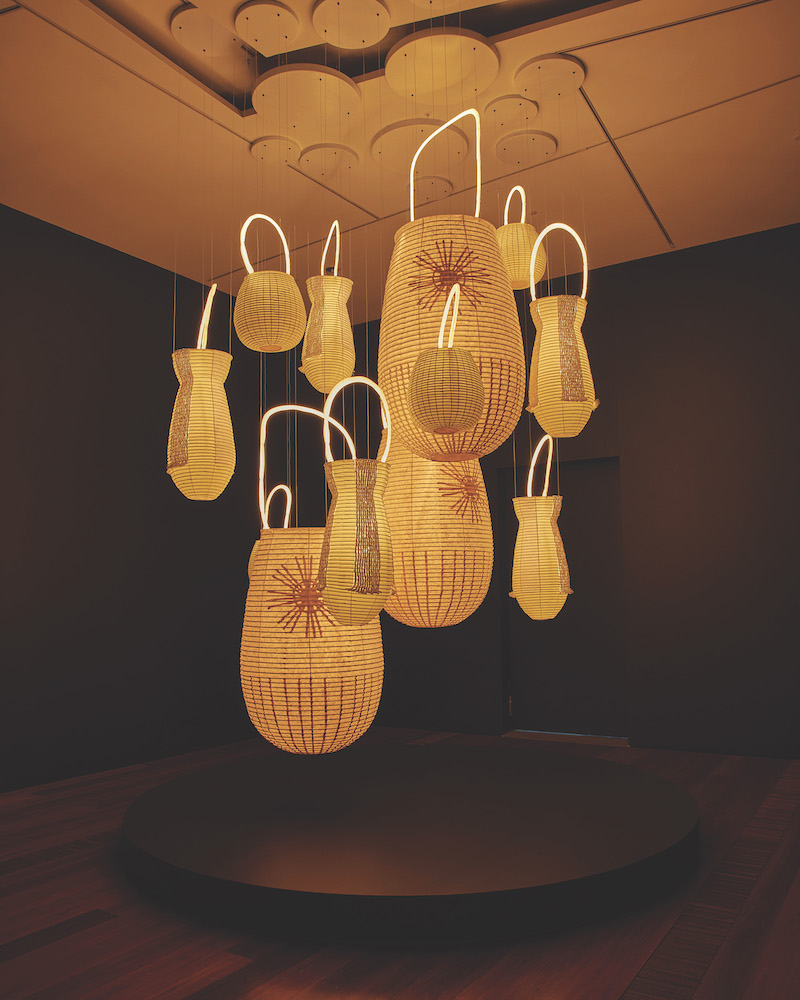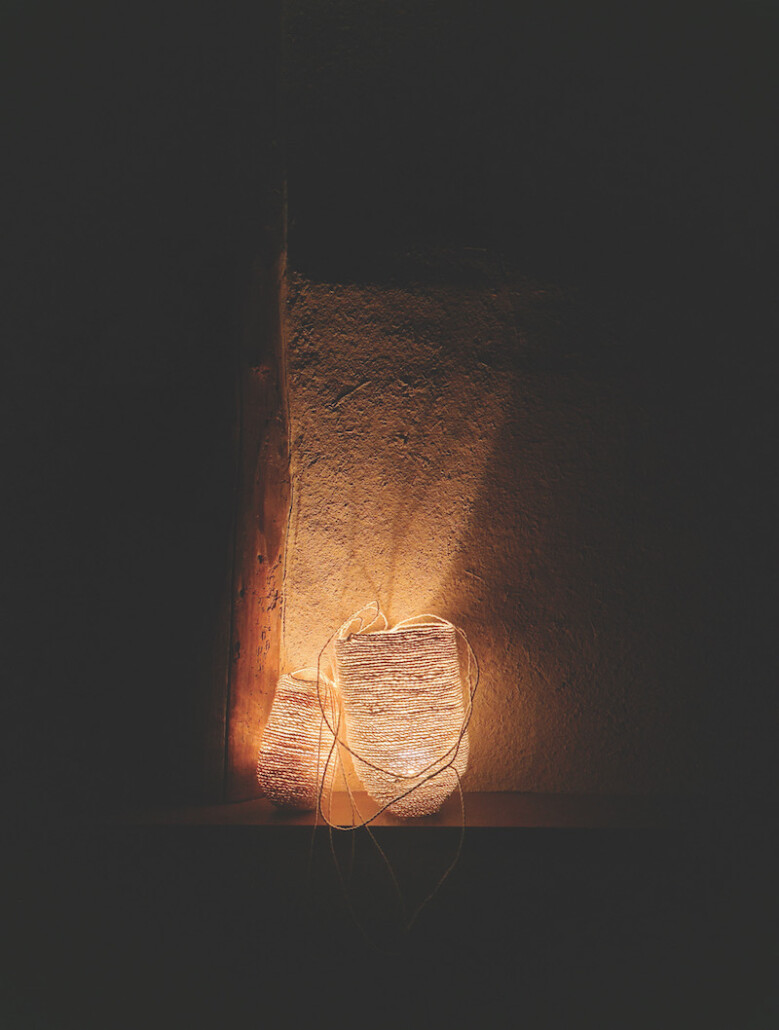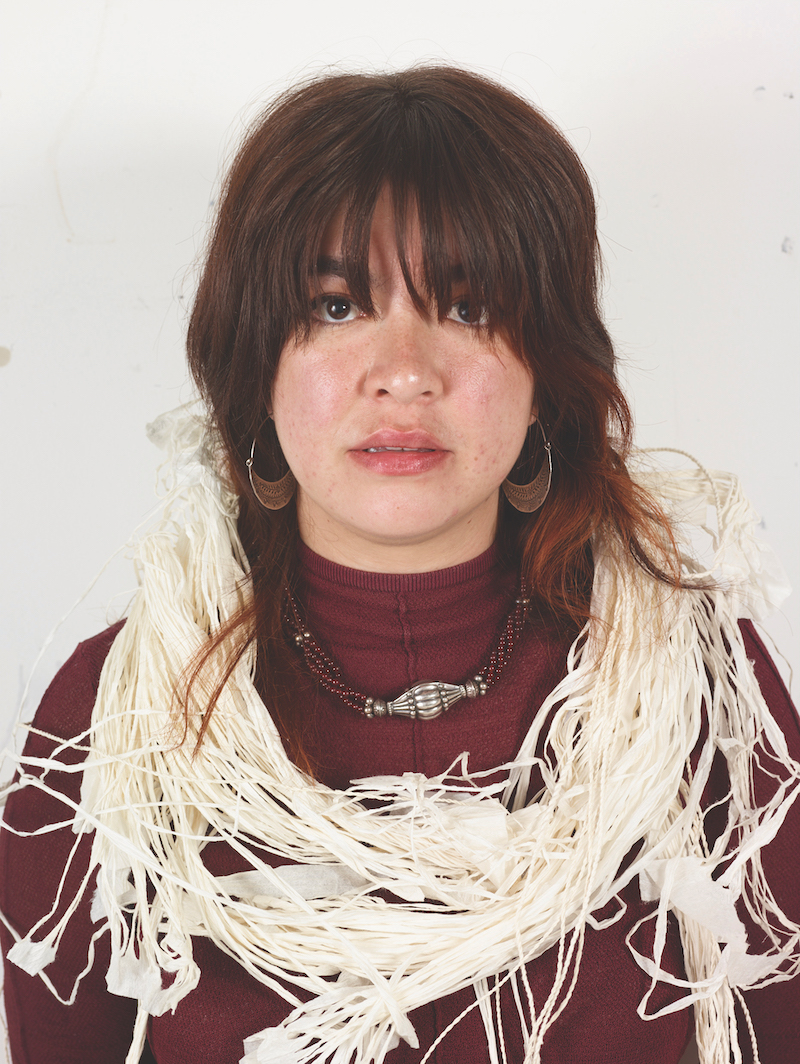Sitting together over cake and coffee on a brisk Friday morning, Naarm-based national and internationally exhibited artist, Jenna Lee, speaks affectionately about her collection of Larrakia dictionaries, used in her artworks and gifted by kin. The artist’s thoughtful vision is apparent in how she describes her family, her Larrakia community and Country, her time in Meanjin (Brisbane) and her respect for the people that have supported her journey. A Gulumerridjin (Larrakia), Wardaman and KarraJarri Saltwater woman with mixed Japanese, Chinese, Filipino and Anglo-Australian ancestry, Lee focuses on ancestral material born from her father’s cultural learnings and her mother’s skills in papercraft. One of the evident processes for the artist is uplifting the complexities of Aboriginal words.
Lee’s practice encompasses photography, works on paper, video and projection, objects, design and sound. Last year, Lee travelled to Japan to undertake a residency at Kyoto Art Center, where she formed her weaving and photography series To make light, one translation of the Larrakia word balarr, in which she responds to the enlightenment of her open studio research and exploration into similar characteristics between dilly bags and Japanese lanterns.
Lee, without all her usual materials, turned towards specifically using Larrakia dictionaries. The soft glow of her baskets highlights the cultural memory of the weaving and time she spent in marrying the ancient techniques of Aboriginal string making and Japanese paper cloth. This was transformative to her practice; born from her relationship with Kojima Shōten, a traditional paper lantern-making space in Kyoto, Lee’s work has flowed into her Melbourne Now exhibit Balarr (To become light), 2023, a cultural exchange collection of large-scale dilly bags and paper-made lanterns painted with Gulumerridjin ochre. The lanterns are a reminder of how sharing traditions strengthens our global communities.
Lee’s works on paper, to gather, to nourish, to sustain, 2022–23, are exhibiting in the TarraWarra Biennial 2023: ua usiusi fa’ava’asavili, curated by Dr Léuli Eshrāghi. The installation reimagines Larrakia language into food iconography, kept within dilly bags.
According to Lee, “the negative space between the diamonds is cross-hatching, which is more like our traditional mark making.” She speaks to oral traditions disrupting colonial archives, stating, “if we were going to write our own language down, wouldn’t we use our own grid system?” She has reinterpreted writing down language into a new form, reminiscent of her method dictionaries. The configuration of the pieces is purposeful, “the way that the words and icons are installed are like tree seeds up high and root gathering on the bottom. It depicts the ecosystem. I wanted people to feel like they were surrounded,” Lee says, “because our language is so abundant, and so is the landscape.” Rooted in her blood memory, Lee’s moving practice continues to reach new heights.
Lee is currently working on a digital commission for Now You’re Speakin’ My Language, curated by Kate ten Buuren, a program partnership between the Institute of Modern Art, Brisbane, and NOWNESS ASIA. Stemming from Lee’s love for ASMR cooking videos, the film centres around the preparation and cooking of lotus root. Representing the uncomfortable, and sometimes guilty feeling of learning language for the first time, Lee describes the lotus root as “a metaphor for language that we put in all this work to learn one word or to relearn one word.” Her father whispers the Larrakia word for lotus root throughout the film. Lee states, “by the end of the film, by the end of this process, I’ll know that word.” She then continues, saying “the end shot is a beautiful plate with one single slice on it. It’s the nourishment that knowing one word, this little bite is going to be enough to keep.”
The vision of Lee’s practice, with care for culture, language, traditional techniques, and deep love for family, is felt through the soft light of her dilly bags, the earthy iconography of bush foods, and the meditation of learning a new craft. Her method is full of heart and pride in being an Aboriginal woman, an artist and a storyteller.
Lee’s commission for Now You’re Speakin’ My Language will be available to view online in June at NOWNESS ASIA.
Above: Artist Jenna Lee. Photo: Bronwyn Kidd. Courtesy: the artist and MARS Gallery, Melbourne.

Installation view of Jenna Lee and Kojima Shouten’s Balarr (To become light), 2023. Display as part of the Melbourne Now exhibition at The Ian Potter Centre: NGV Australia. Photo: Sean Fennessy. Courtesy: the artist and MARS Gallery, Melbourne.

Jenna Lee, Image still from gwoyarr-ma (Now You’re Speakin’ My Language), 2023. Single-channel video. Photo and video: Sam Biddle. Courtesy: the artist and MARS Gallery, Melbourne.

Jenna Lee, To carry light together, 2023. Digital photograph printed on Canson Baryta II Photographique 310gsm, 50.5 x 66cm. Edition of 3 + 2AP. Colour grading: Peter Hatzipavlis.
Courtesy: the artist and MARS Gallery, Melbourne.

